YAMAHA YZF-R6 2012 Repair Manual
Manufacturer: YAMAHA, Model Year: 2012, Model line: YZF-R6, Model: YAMAHA YZF-R6 2012Pages: 112, PDF Size: 2.46 MB
Page 61 of 112
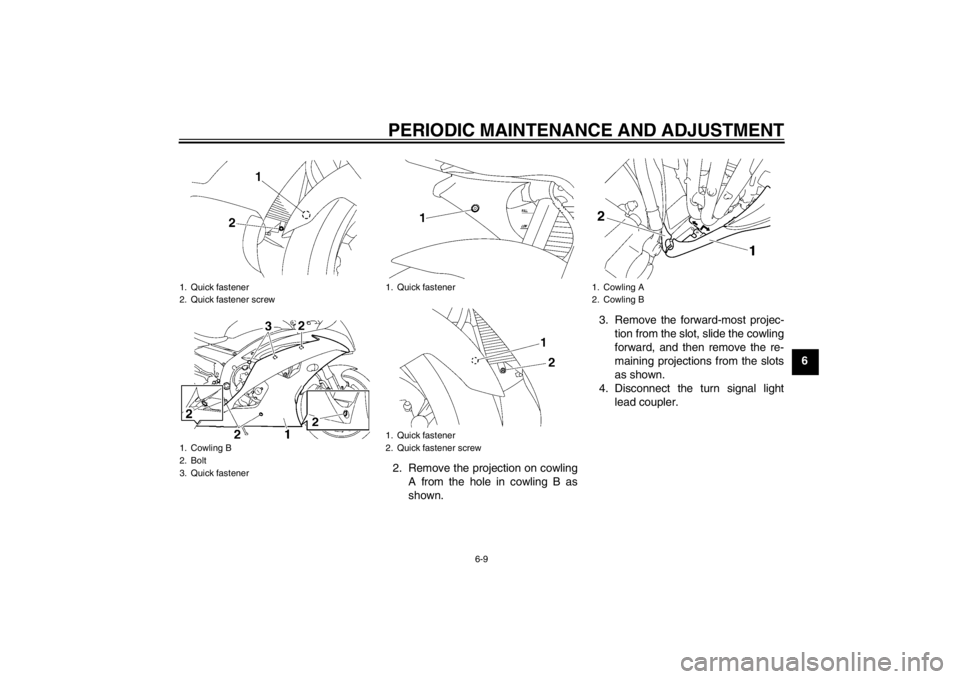
PERIODIC MAINTENANCE AND ADJUSTMENT
6-9
6
2. Remove the projection on cowling A from the hole in cowling B as
shown. 3. Remove the forward-most projec-
tion from the slot, slide the cowling
forward, and then remove the re-
maining projections from the slots
as shown.
4. Disconnect the turn signal light lead coupler.
1. Quick fastener
2. Quick fastener screw
1. Cowling B
2. Bolt
3. Quick fastener
1. Quick fastener
1. Quick fastener
2. Quick fastener screw
1. Cowling A
2. Cowling B
U1JSE0E0.book Page 9 Wednesday, July 27, 2011 10:34 AM
Page 62 of 112
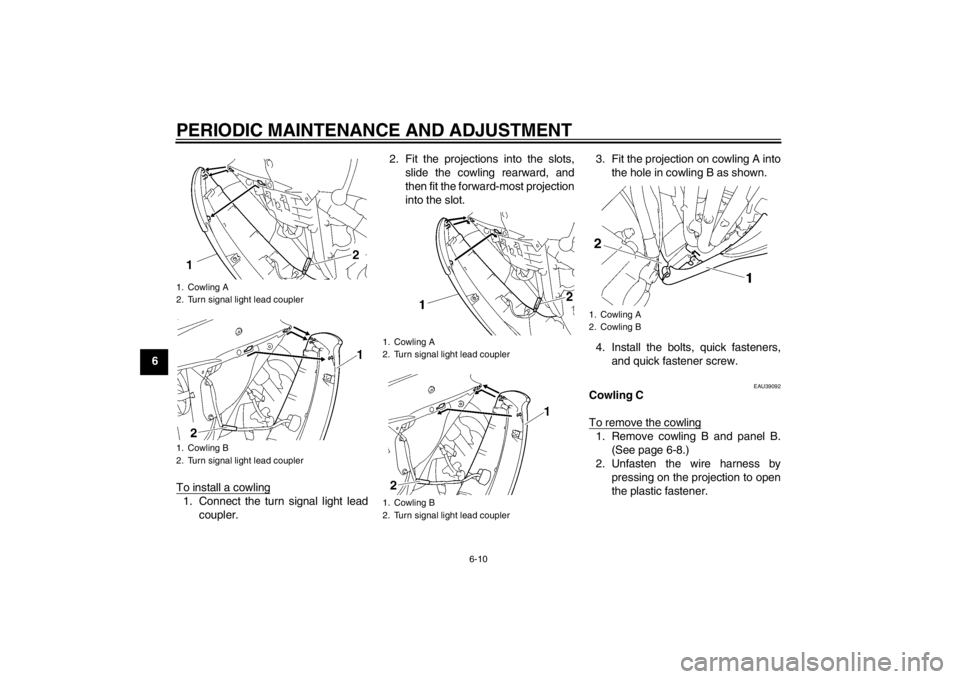
PERIODIC MAINTENANCE AND ADJUSTMENT
6-10
6To install a cowling
1. Connect the turn signal light leadcoupler. 2. Fit the projections into the slots,
slide the cowling rearward, and
then fit the forward-most projection
into the slot. 3. Fit the projection on cowling A into
the hole in cowling B as shown.
4. Install the bolts, quick fasteners, and quick fastener screw.
EAU39092
Cowling C
To remove the cowling1. Remove cowling B and panel B.(See page 6-8.)
2. Unfasten the wire harness by pressing on the projection to open
the plastic fastener.
1. Cowling A
2. Turn signal light lead coupler
1. Cowling B
2. Turn signal light lead coupler
1. Cowling A
2. Turn signal light lead coupler
1. Cowling B
2. Turn signal light lead coupler
1. Cowling A
2. Cowling B
U1JSE0E0.book Page 10 Wednesday, July 27, 2011 10:34 AM
Page 63 of 112
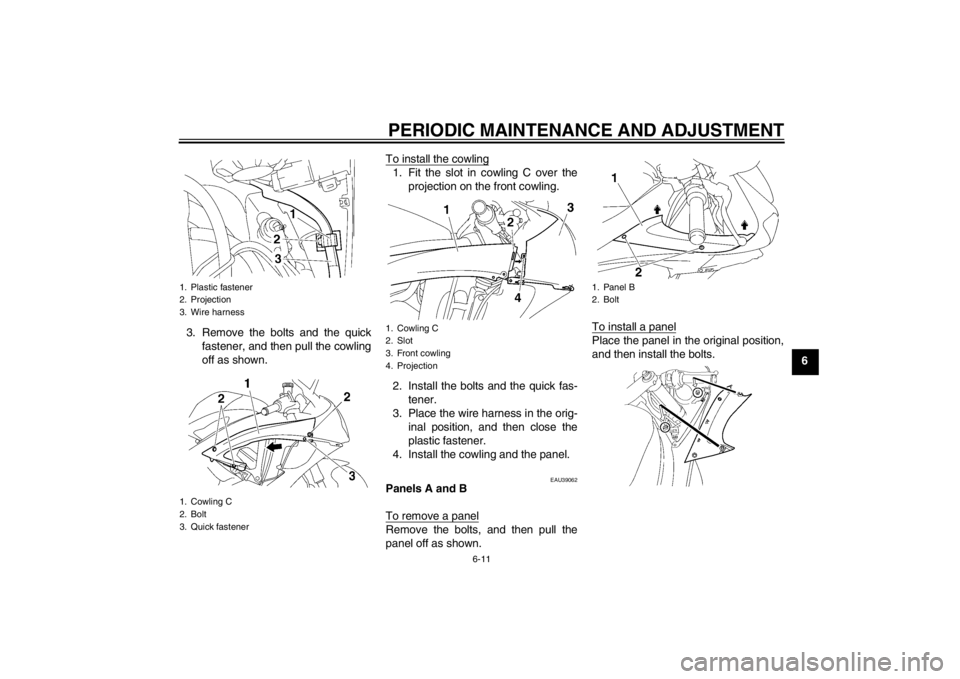
PERIODIC MAINTENANCE AND ADJUSTMENT
6-11
6
3. Remove the bolts and the quick
fastener, and then pull the cowling
off as shown. To install the cowling
1. Fit the slot in cowling C over the
projection on the front cowling.
2. Install the bolts and the quick fas- tener.
3. Place the wire harness in the orig- inal position, and then close the
plastic fastener.
4. Install the cowling and the panel.
EAU39062
Panels A and B
To remove a panelRemove the bolts, and then pull the
panel off as shown. To install a panel
Place the panel in the original position,
and then install the bolts.
1. Plastic fastener
2. Projection
3. Wire harness
1. Cowling C
2. Bolt
3. Quick fastener
1. Cowling C
2. Slot
3. Front cowling
4. Projection
1. Panel B
2. Bolt
U1JSE0E0.book Page 11 Wednesday, July 27, 2011 10:34 AM
Page 64 of 112
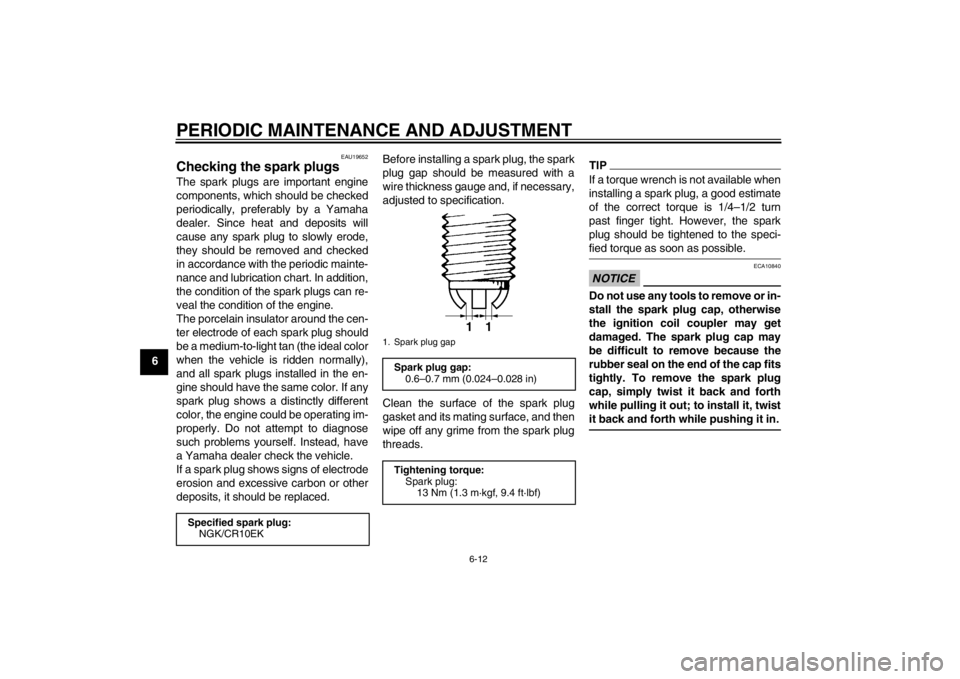
PERIODIC MAINTENANCE AND ADJUSTMENT
6-12
6
EAU19652
Checking the spark plugs The spark plugs are important engine
components, which should be checked
periodically, preferably by a Yamaha
dealer. Since heat and deposits will
cause any spark plug to slowly erode,
they should be removed and checked
in accordance with the periodic mainte-
nance and lubrication chart. In addition,
the condition of the spark plugs can re-
veal the condition of the engine.
The porcelain insulator around the cen-
ter electrode of each spark plug should
be a medium-to-light tan (the ideal color
when the vehicle is ridden normally),
and all spark plugs installed in the en-
gine should have the same color. If any
spark plug shows a distinctly different
color, the engine could be operating im-
properly. Do not attempt to diagnose
such problems yourself. Instead, have
a Yamaha dealer check the vehicle.
If a spark plug shows signs of electrode
erosion and excessive carbon or other
deposits, it should be replaced.Before installing a spark plug, the spark
plug gap should be measured with a
wire thickness gauge and, if necessary,
adjusted to specification.
Clean the surface of the spark plug
gasket and its mating surface, and then
wipe off any grime from the spark plug
threads.
TIPIf a torque wrench is not available when
installing a spark plug, a good estimate
of the correct torque is 1/4–1/2 turn
past finger tight. However, the spark
plug should be tightened to the speci-
fied torque as soon as possible.NOTICE
ECA10840
Do not use any tools to remove or in-
stall the spark plug cap, otherwise
the ignition coil coupler may get
damaged. The spark plug cap may
be difficult to remove because the
rubber seal on the end of the cap fits
tightly. To remove the spark plug
cap, simply twist it back and forth
while pulling it out; to install it, twist
it back and forth while pushing it in.
Specified spark plug:
NGK/CR10EK
1. Spark plug gapSpark plug gap:0.6–0.7 mm (0.024–0.028 in)
Tightening torque: Spark plug:13 Nm (1.3 m·kgf, 9.4 ft·lbf)
1
1
U1JSE0E0.book Page 12 Wednesday, July 27, 2011 10:34 AM
Page 65 of 112
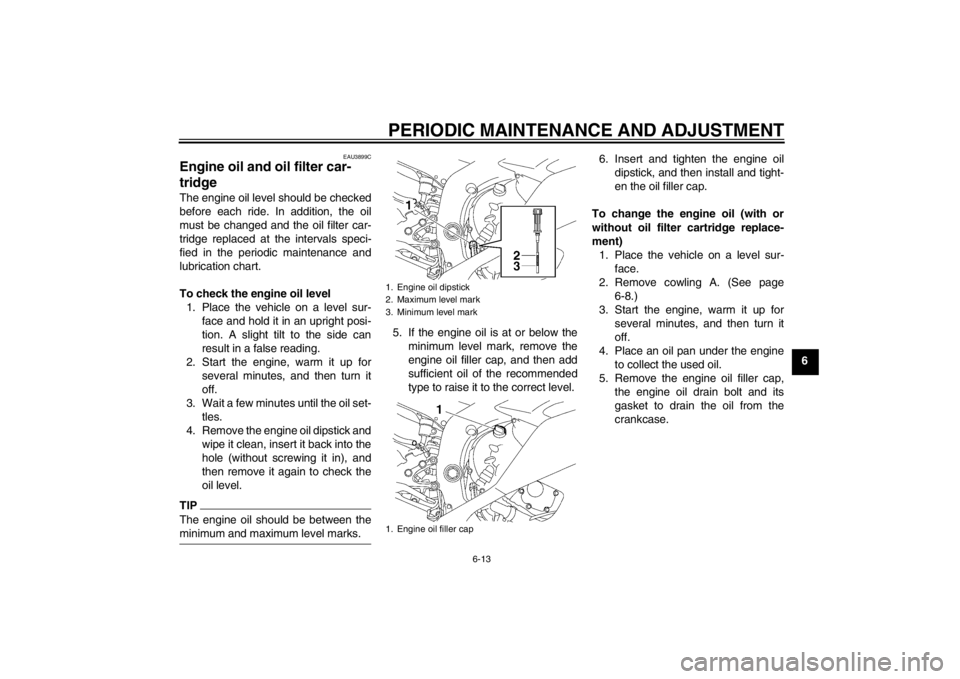
PERIODIC MAINTENANCE AND ADJUSTMENT
6-13
6
EAU3899C
Engine oil and oil filter car-
tridge The engine oil level should be checked
before each ride. In addition, the oil
must be changed and the oil filter car-
tridge replaced at the intervals speci-
fied in the periodic maintenance and
lubrication chart.
To check the engine oil level1. Place the vehicle on a level sur- face and hold it in an upright posi-
tion. A slight tilt to the side can
result in a false reading.
2. Start the engine, warm it up for several minutes, and then turn it
off.
3. Wait a few minutes until the oil set- tles.
4. Remove the engine oil dipstick and wipe it clean, insert it back into the
hole (without screwing it in), and
then remove it again to check the
oil level.TIPThe engine oil should be between the
minimum and maximum level marks.
5. If the engine oil is at or below theminimum level mark, remove the
engine oil filler cap, and then add
sufficient oil of the recommended
type to raise it to the correct level. 6. Insert and tighten the engine oil
dipstick, and then install and tight-
en the oil filler cap.
To change the engine oil (with or
without oil filter cartridge replace-
ment) 1. Place the vehicle on a level sur- face.
2. Remove cowling A. (See page 6-8.)
3. Start the engine, warm it up for several minutes, and then turn it
off.
4. Place an oil pan under the engine to collect the used oil.
5. Remove the engine oil filler cap, the engine oil drain bolt and its
gasket to drain the oil from the
crankcase.1. Engine oil dipstick
2. Maximum level mark
3. Minimum level mark
1. Engine oil filler cap
U1JSE0E0.book Page 13 Wednesday, July 27, 2011 10:34 AM
Page 66 of 112
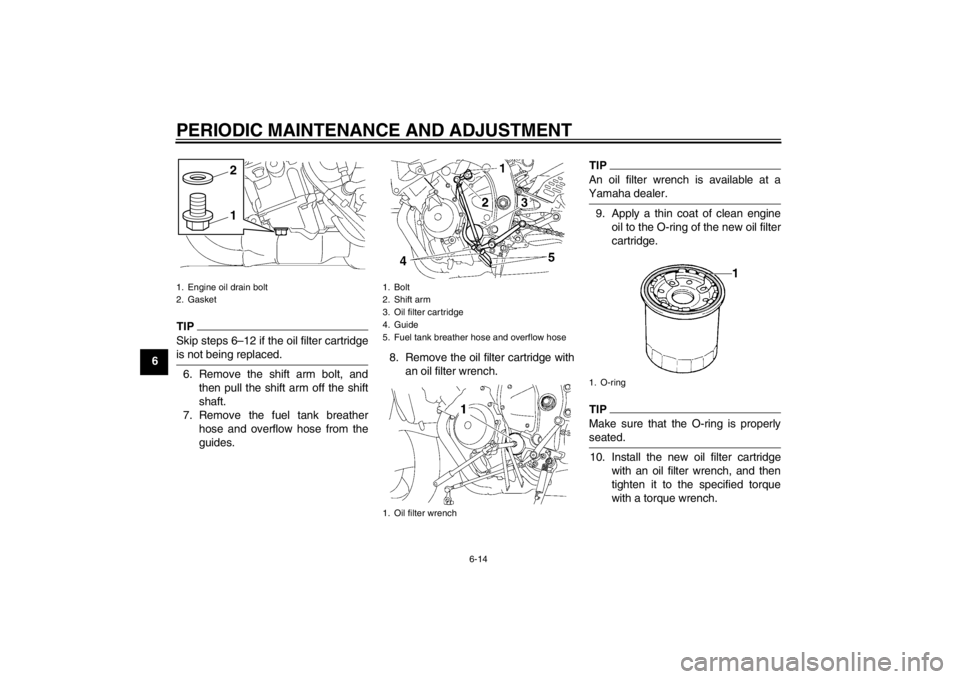
PERIODIC MAINTENANCE AND ADJUSTMENT
6-14
6
TIPSkip steps 6–12 if the oil filter cartridge
is not being replaced.6. Remove the shift arm bolt, andthen pull the shift arm off the shift
shaft.
7. Remove the fuel tank breather hose and overflow hose from the
guides. 8. Remove the oil filter cartridge with
an oil filter wrench.
TIPAn oil filter wrench is available at a
Yamaha dealer.9. Apply a thin coat of clean engine oil to the O-ring of the new oil filter
cartridge.TIPMake sure that the O-ring is properly
seated.10. Install the new oil filter cartridge with an oil filter wrench, and then
tighten it to the specified torque
with a torque wrench.
1. Engine oil drain bolt
2. Gasket
12
1. Bolt
2. Shift arm
3. Oil filter cartridge
4. Guide
5. Fuel tank breather hose and overflow hose
1. Oil filter wrench
1. O-ring
U1JSE0E0.book Page 14 Wednesday, July 27, 2011 10:34 AM
Page 67 of 112
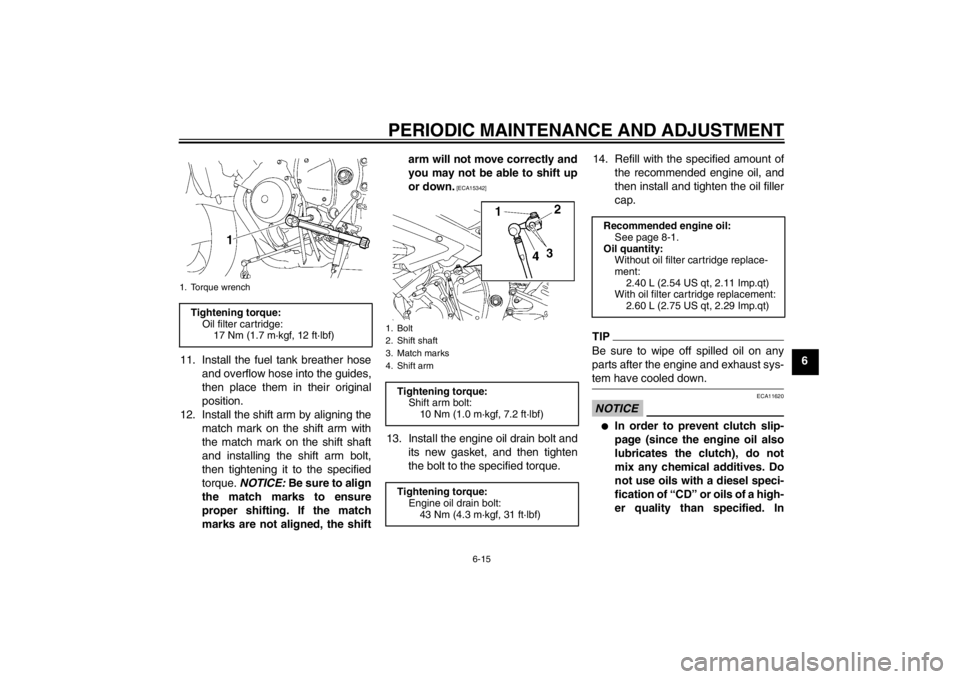
PERIODIC MAINTENANCE AND ADJUSTMENT
6-15
6
11. Install the fuel tank breather hose
and overflow hose into the guides,
then place them in their original
position.
12. Install the shift arm by aligning the match mark on the shift arm with
the match mark on the shift shaft
and installing the shift arm bolt,
then tightening it to the specified
torque. NOTICE: Be sure to align
the match marks to ensure
proper shifting. If the match
marks are not aligned, the shift arm will not move correctly and
you may not be able to shift up
or down.
[ECA15342]
13. Install the engine oil drain bolt and
its new gasket, and then tighten
the bolt to the specified torque. 14. Refill with the specified amount of
the recommended engine oil, and
then install and tighten the oil filler
cap.
TIPBe sure to wipe off spilled oil on any
parts after the engine and exhaust sys-
tem have cooled down.NOTICE
ECA11620
●
In order to prevent clutch slip-
page (since the engine oil also
lubricates the clutch), do not
mix any chemical additives. Do
not use oils with a diesel speci-
fication of “CD” or oils of a high-
er quality than specified. In
1. Torque wrenchTightening torque:Oil filter cartridge:17 Nm (1.7 m·kgf, 12 ft·lbf)
1. Bolt
2. Shift shaft
3. Match marks
4. Shift arm
Tightening torque: Shift arm bolt:10 Nm (1.0 m·kgf, 7.2 ft·lbf)
Tightening torque: Engine oil drain bolt:
43 Nm (4.3 m·kgf, 31 ft·lbf)
Recommended engine oil:See page 8-1.
Oil quantity: Without oil filter cartridge replace-
ment: 2.40 L (2.54 US qt, 2.11 Imp.qt)
With oil filter cartridge replacement:
2.60 L (2.75 US qt, 2.29 Imp.qt)
U1JSE0E0.book Page 15 Wednesday, July 27, 2011 10:34 AM
Page 68 of 112
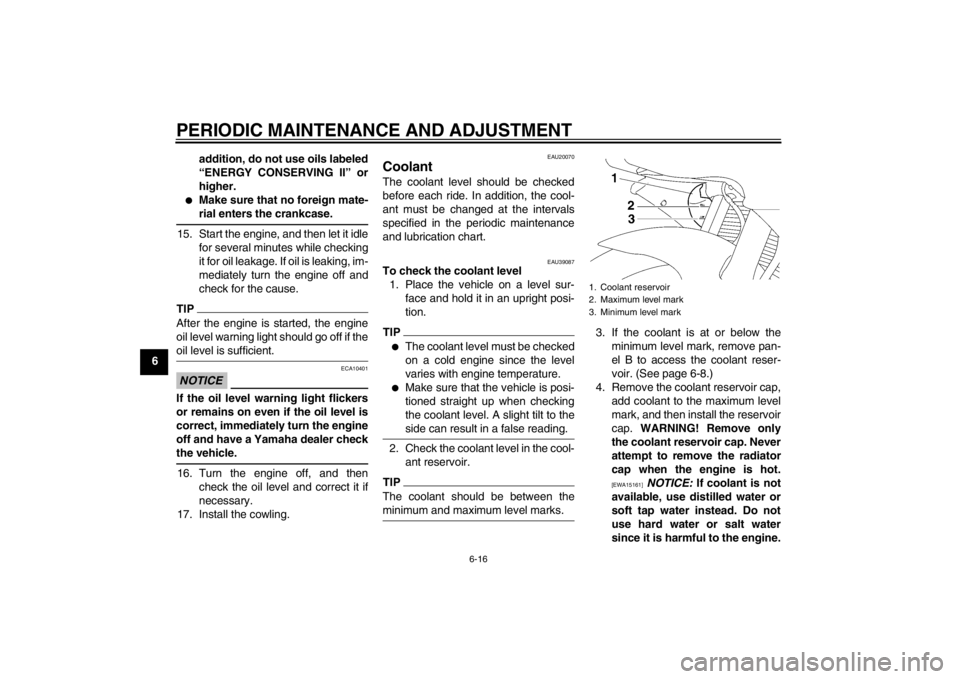
PERIODIC MAINTENANCE AND ADJUSTMENT
6-16
6addition, do not use oils labeled
“ENERGY CONSERVING II” or
higher.
●
Make sure that no foreign mate-
rial enters the crankcase.
15. Start the engine, and then let it idle
for several minutes while checking
it for oil leakage. If oil is leaking, im-
mediately turn the engine off and
check for the cause.TIPAfter the engine is started, the engine
oil level warning light should go off if the
oil level is sufficient.NOTICE
ECA10401
If the oil level warning light flickers
or remains on even if the oil level is
correct, immediately turn the engine
off and have a Yamaha dealer check
the vehicle.16. Turn the engine off, and thencheck the oil level and correct it if
necessary.
17. Install the cowling.
EAU20070
Coolant The coolant level should be checked
before each ride. In addition, the cool-
ant must be changed at the intervals
specified in the periodic maintenance
and lubrication chart.
EAU39087
To check the coolant level 1. Place the vehicle on a level sur- face and hold it in an upright posi-
tion.TIP●
The coolant level must be checked
on a cold engine since the level
varies with engine temperature.
●
Make sure that the vehicle is posi-
tioned straight up when checking
the coolant level. A slight tilt to the
side can result in a false reading.
2. Check the coolant level in the cool-ant reservoir.TIPThe coolant should be between the
minimum and maximum level marks.
3. If the coolant is at or below theminimum level mark, remove pan-
el B to access the coolant reser-
voir. (See page 6-8.)
4. Remove the coolant reservoir cap, add coolant to the maximum level
mark, and then install the reservoir
cap. WARNING! Remove only
the coolant reservoir cap. Never
attempt to remove the radiator
cap when the engine is hot.
[EWA15161]
NOTICE: If coolant is not
available, use distilled water or
soft tap water instead. Do not
use hard water or salt water
since it is harmful to the engine.
1. Coolant reservoir
2. Maximum level mark
3. Minimum level mark
U1JSE0E0.book Page 16 Wednesday, July 27, 2011 10:34 AM
Page 69 of 112
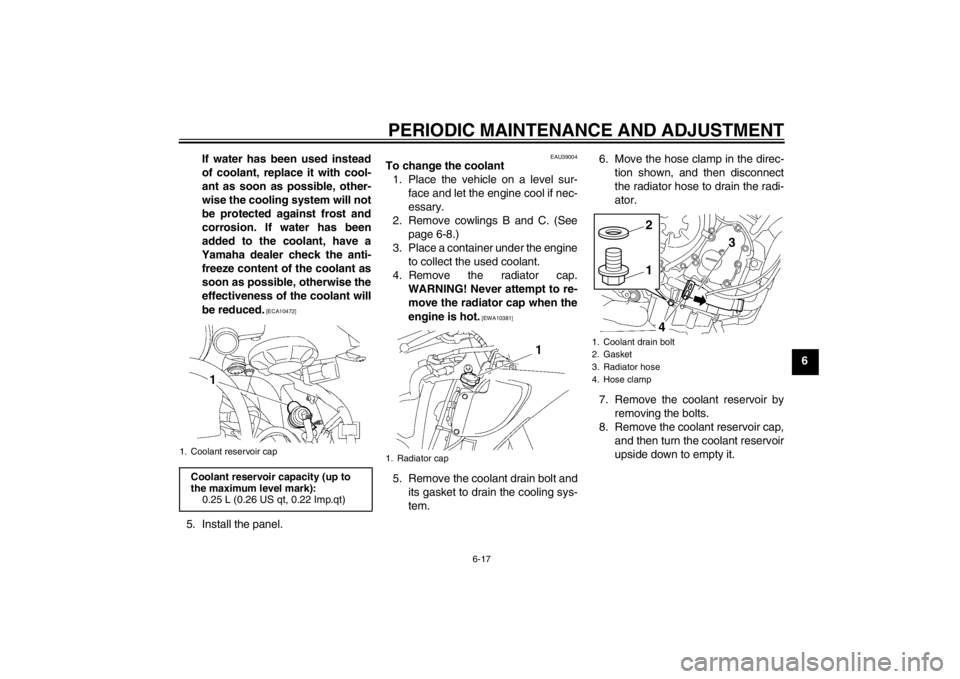
PERIODIC MAINTENANCE AND ADJUSTMENT
6-17
6
If water has been used instead
of coolant, replace it with cool-
ant as soon as possible, other-
wise the cooling system will not
be protected against frost and
corrosion. If water has been
added to the coolant, have a
Yamaha dealer check the anti- freeze content of the coolant as
soon as possible, otherwise the
effectiveness of the coolant will
be reduced.
[ECA10472]
5. Install the panel.
EAU39004
To change the coolant 1. Place the vehicle on a level sur- face and let the engine cool if nec-
essary.
2. Remove cowlings B and C. (See page 6-8.)
3. Place a container under the engine to collect the used coolant.
4. Remove the radiator cap. WARNING! Never attempt to re-move the radiator cap when the
engine is hot.
[EWA10381]
5. Remove the coolant drain bolt and its gasket to drain the cooling sys-
tem. 6. Move the hose clamp in the direc-
tion shown, and then disconnect
the radiator hose to drain the radi-
ator.
7. Remove the coolant reservoir by removing the bolts.
8. Remove the coolant reservoir cap, and then turn the coolant reservoir
upside down to empty it.
1. Coolant reservoir capCoolant reservoir capacity (up to
the maximum level mark):0.25 L (0.26 US qt, 0.22 Imp.qt)
1. Radiator cap
1. Coolant drain bolt
2. Gasket
3. Radiator hose
4. Hose clamp
1
4
3
2
U1JSE0E0.book Page 17 Wednesday, July 27, 2011 10:34 AM
Page 70 of 112
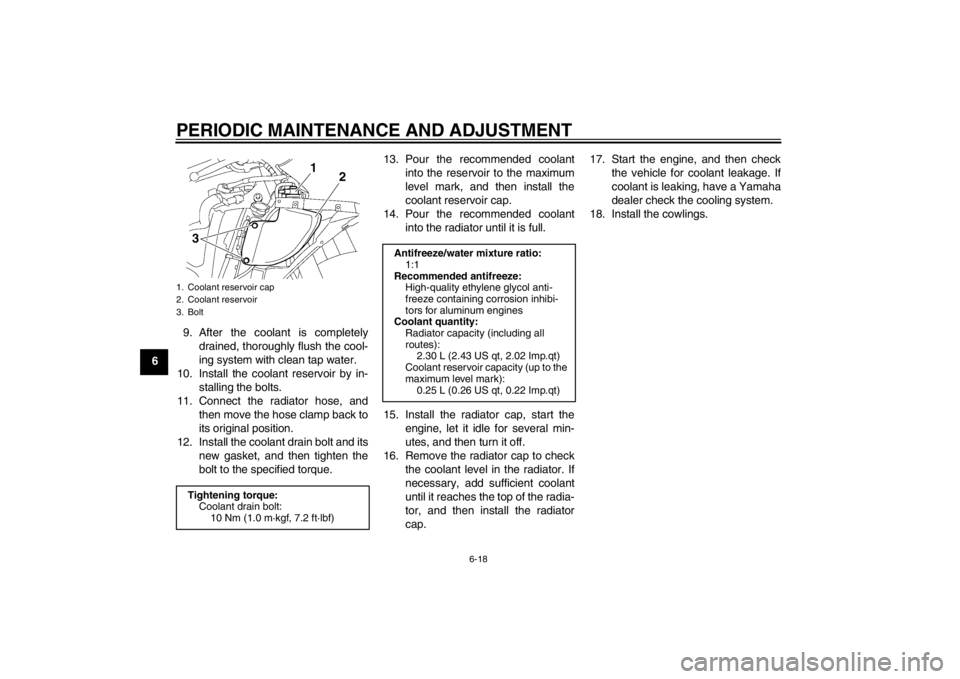
PERIODIC MAINTENANCE AND ADJUSTMENT
6-18
69. After the coolant is completely
drained, thoroughly flush the cool-
ing system with clean tap water.
10. Install the coolant reservoir by in- stalling the bolts.
11. Connect the radiator hose, and then move the hose clamp back to
its original position.
12. Install the coolant drain bolt and its new gasket, and then tighten the
bolt to the specified torque. 13. Pour the recommended coolant
into the reservoir to the maximum
level mark, and then install the
coolant reservoir cap.
14. Pour the recommended coolant into the radiator until it is full.
15. Install the radiator cap, start the engine, let it idle for several min-
utes, and then turn it off.
16. Remove the radiator cap to check the coolant level in the radiator. If
necessary, add sufficient coolant
until it reaches the top of the radia-
tor, and then install the radiator
cap. 17. Start the engine, and then check
the vehicle for coolant leakage. If
coolant is leaking, have a Yamaha
dealer check the cooling system.
18. Install the cowlings.
1. Coolant reservoir cap
2. Coolant reservoir
3. BoltTightening torque: Coolant drain bolt:
10 Nm (1.0 m·kgf, 7.2 ft·lbf)
2
1
3
Antifreeze/water mixture ratio: 1:1
Recommended antifreeze: High-quality ethylene glycol anti-
freeze containing corrosion inhibi-
tors for aluminum engines
Coolant quantity:
Radiator capacity (including all
routes):2.30 L (2.43 US qt, 2.02 Imp.qt)
Coolant reservoir capacity (up to the
maximum level mark): 0.25 L (0.26 US qt, 0.22 Imp.qt)
U1JSE0E0.book Page 18 Wednesday, July 27, 2011 10:34 AM